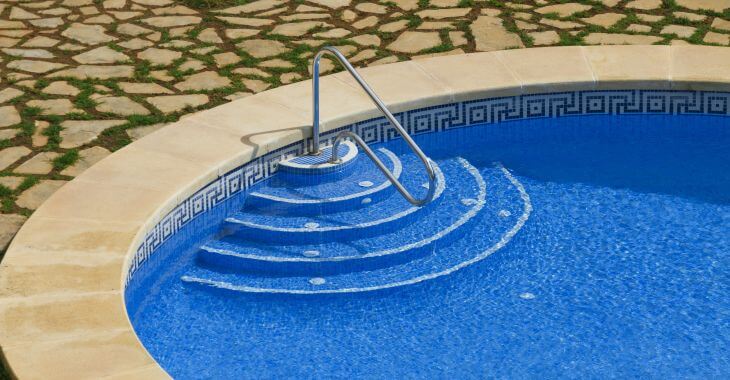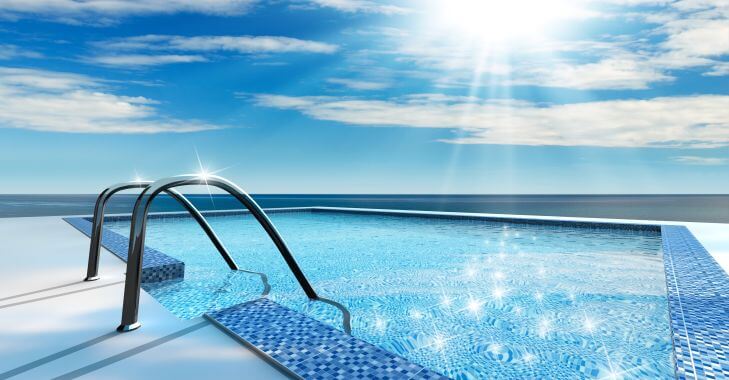What Are the Best Options in Pool Coping?

There are many elements that contribute to a beautiful and functional swimming pool. One of the key elements that connects the pool shell and decking is the pool coping. Choosing the right materials and design for the edge of your pool can have a significant impact on the aesthetics and longevity of your pool. What is pool coping and what are the best design options when installing this pool component? Here is what you should know about choosing the right pool coping.
What is Pool Coping?
Coping is a term that is used by contractors, builders and architects to describe the cap or top element of a wall. It is both an aesthetic and functional component; it provides a cosmetic adornment for where the wall ends and seals the top. Pool coping is the top edge to the pool’s walls, concealing where the top of the pool shell meets the pool decking while providing a design element and protecting the pool.
Pool coping can be simple or elaborate, depending on the preference and budget of the pool owner. It is important to protect the swimming pool and provide certain functions. The coping should help maintain the pool’s integrity by providing the following functions:
- Seal the top of the pool shell and keep water from seeping behind the pool walls
- Direct water away from the pool’s edge toward pool decking drains
- Pool coping can provide a safe edging around the pool to prevent slipping
- The lip of the coping can help keep debris from entering the pool water
- Pool coping gives swimmer’s a place to sit comfortably on the edge of the pool
Whether it is a basic edging around the top of the pool or an aesthetically-pleasing design, pool coping is an important part of designing and building a pool. If you think about it, pool coping is used more than any other part of the pool. Most people like to sit on the edge, or crawl out of the pool, utilizing the pool coping over and over during one day at the pool. While the function is important, there are many reasons to use coping to improve the overall appearance for a beautiful pool.
Aesthetic Design of Pool Coping
Pool coping is a very functional component – it is vital that it provides the needed seal around the top of the pool walls while offering a non-slip, yet smooth surface for swimmers. The coping should slope to allow water to drain away from the pool. But it can do all these things and still be a gorgeous design element for improved aesthetics. You can use many different materials, shapes and colors to highlight the edge of your pool with the right type of coping.
- Concrete Pool Coping
- One of the most common options is concrete pool coping. This can be a simply functional element, or you can choose options to make it more aesthetically-pleasing. There is poured concrete pool coping, which provides a seamless edge, or precast concrete, which comes in a wide variety of textures and designs. Poured concrete is usually more expensive, but it provides a uniform look to the pool edge while precast concrete options can cost less and have more variety. Both poured and precast concrete pool coping are susceptible to cracking.
- Concrete Pool Coping Pavers
- A popular design option for concrete pool coping is concrete pavers. They can mimic the appearance of pool coping stone pavers but are much less expensive. Concrete pavers for pool coping are cost-effective and easy to maintain and repair; they are less likely to crack like poured or precast concrete pool coping. Plus, there are many design options available for concrete pavers that are perfect for edging the pool.
- Pool Coping – Stone Pavers
- Natural stone pool coping is an elegant design option for your pool. Travertine, marble and many other types of stone are a beautiful edging for the pool and blend well with a stone or paver pool deck or patio. Pool coping of stone is usually the most expensive option, but it can last for decades and offers easy maintenance. Many popular pool coping stone pavers are slip-resistant and stay cool to the touch for excellent function.
On top of the type of material you choose for your pool coping, you will also need to decide the style and design. Styles include bullnose, top-mount, rough-cut, cantilevered and flat-mount, depending on what material you use and your comfort or aesthetic preferences.

Pool coping is a crucial component of your pool – choosing the right material and style can help improve the longevity and safety of your swimming pool, as well as add an aesthetic beauty to your pool area. To learn more about pool coping options, contact your local landscaper or pool design expert that offers pool coping installation.


